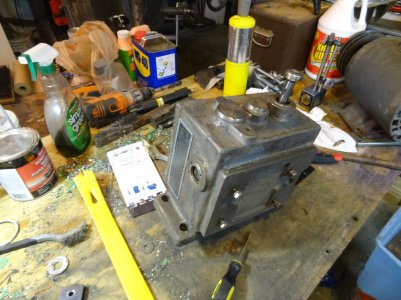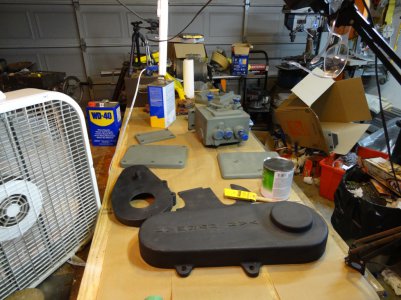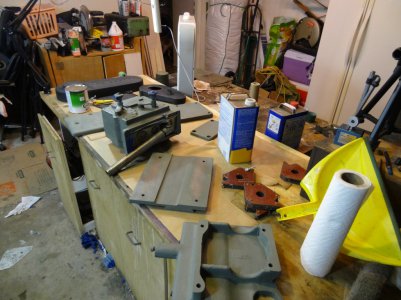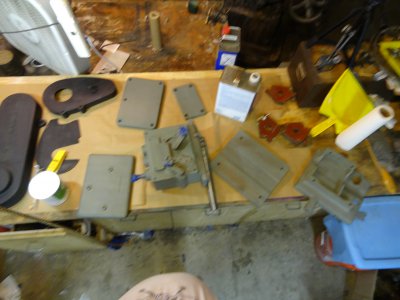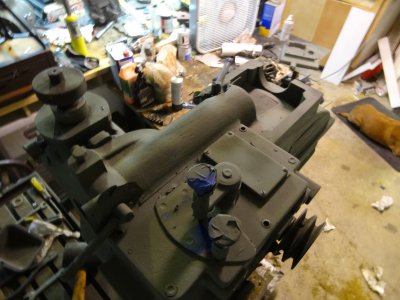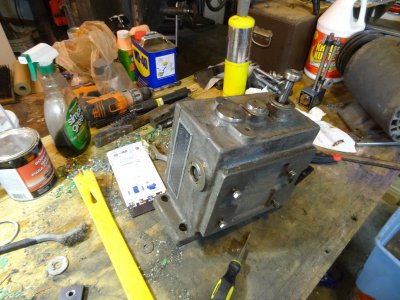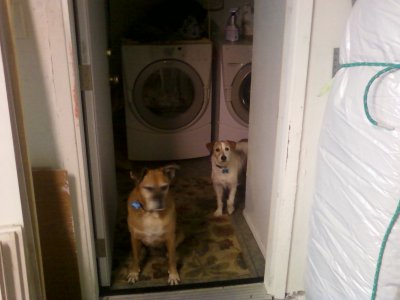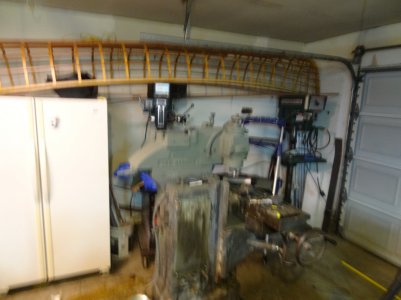Painting the VN-12
I didn't like the multicolored paint scheme. The black, white, green and orange didn't go with the shop decor. A coat of paint was required.
I started chipping the paint off with a scaler from HF. It worked really well up to the point that my 25 year old Craftsman compressor ran out of breath. The compressor runs for about 45 minutes to fill the 20 gallon tank.
I moved to wire brush wheels and cups on the 4 1/2 angle grinder. Yep, sparks flew, ozone reeked, and the motor stopped. The $12.95 angle grinder from HF proved it was disposable.
I read Nelson's comment he had good luck with Citrus Strip. 35 years ago I attempted to chemically strip some paint from something. All I could remember is it didn't work very well, stunk awful, and gave me a head-ache for the better part of a week. But, Nelson was using it in his basement and said the smell wasn't bad at all. Off to box store I ran.
What a difference 35 years makes. This stuff took of 2, 3, sometimes 4 coats of paint in one application. It had very little smell, and what smell it had was pleasant. On the back of the ram where the long arch slopes down, some of the paint literally slid off on to the floor.
With all the paint stripped, I turned to degreasing. This seems like such an obvious task. Spray, scrub, wipe. How hard could it be? I must have used five rolls of paper towels. I still could pick up a lot of oily residue when I wiped a dry towel across parts of the machine. After some number of days of trying to get it clean, I went to the auto parts store and asked for a serious cleaner for a greasy old milling machine. The guy pointed me towards Purple Cleaner/Degreaser. I told him my troubles and about the tennis elbow I was getting by wipe-on, wipe-off. He said not to wipe off, but
rinse off. Dry with a clean paper towel. Hmmm, I didn't thin
RINSING could really be all that important. Two short hours later I was done. Purple Cleaner, wire brushes, steel wool, tennis elbow and a bucket with warm water had cleaned (and rinsed) years of gunk, grime and embedded chips. Whew, that felt good.
Now, I had a bare naked machine rusting in the wind. I had not thought about buying any primer in advance. Off to big box I run, to see what I could get at 9:45 on a Saturday night. I was a little rushed in my choices, but I finally chose Rustoleum self etching primer. I liked and feared the "etching" part of the name. Etching would give it a good surface to bond too, right? But would it gouge my beautiful dove tails and load bearing surfaces? Enquiring minds wanted to know
before 4 cans of this stuff were released into Eden.
At 10:15 PM I'm spraying self-etching primer on a piece of bare sheet metal in a garbage bag (deep haunting voice in my head kept saying "Contain the ACID!"). How in the hell do kids huff this stuff? I wanted to let it dry for an hour or two before I confirmed it wouldn't harm the surface. I knew I should go to bed, but the machine was rusting before my very eyes, at least that's what the voice was saying.
Out comes the painters tape an razor knife. Taping every machined surface, placard, shaft, knob etc. Whew, just barely saved it. It's about be-witching hour in my little Eden. I had to check the sheet metal and the
ACID paint.
It looked fine. In fact it looked good. I scratched it with my finger nail, it didn't budge, I fully expected it to peel up. It had dried probably four hours. That's impressive. Of course, with a out come that good, who could sleep? Might as well prime the beauty before she collapses into a pile of rust. It has been, like, 12 hours since I took off the last of the paint.
A short time later everything was primed and drying. My head was spinning from some lack of sleep, some propellant but mostly giddiness over saving the life of such a noble machine as the Van Norman 12. It was, at last, time to go to bed.
Evan R.
P.S. You are all asking yourselves "Where the hell are the pictures! We want pictures!" Those with stignatism(sp?) might want to look away now. A dyslexic, drunk monkey ran into the shop and took these pictures. And these were the best of the best.
